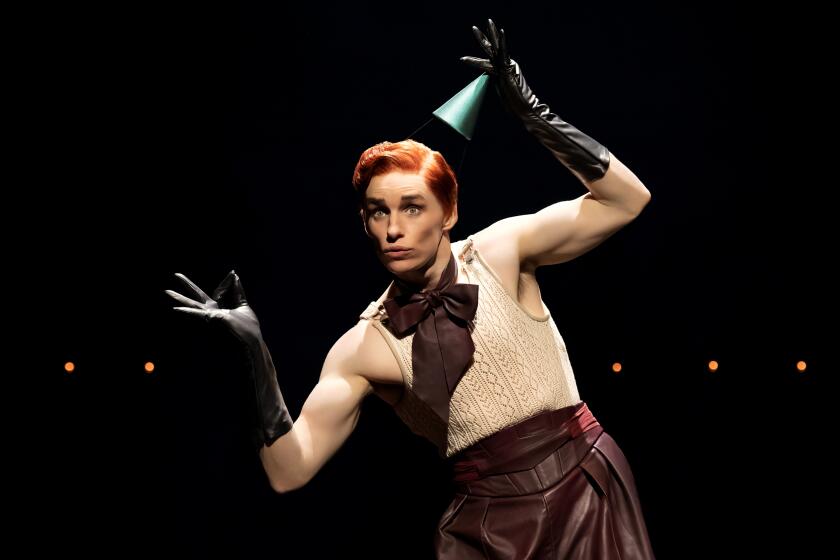LACMA buys seven works, led by Rauschenberg and Sullivan
Sometimes bigger is better when buying art by committee. At this year’s Collectors Committee weekend, the L.A. County Museum of Art bought $2.5-million worth of artwork to add to its permanent collection, including two larger-than-life works: a 60-foot-long Robert Rauschenberg screenprint that shows a collage of newspaper articles from 1970, bought for $775,000, and a nearly 10-foot-tall elevator surround that Louis Sullivan designed around 1892 for the Chicago Stock Exchange Building, bought for $177,500.
Other acquisitions included a tiny Durer print of “Saint Jerome in his Study” from 1514, a pair of oil-on-copper paintings from the 1740s by Mexican artist Nicolas Enriquez depicting scenes from the life of the Virgin Mary, a 12th-century Buddhist sculpture carved from Zelkova wood, a 1996 photograph by Shirin Neshat from her series “Women of Allah,” and a three-channel Bruce Conner video “Three Screen Ray” from 1961.
The weekend activities began Friday night with dinners prepared by in-demand chefs like Tom Colicchio and Thomas Keller and hosted by LACMA patrons like Jane and Terry Semel and Willow Bay and Bob Iger. The event culminated Saturday night with a gala at the museum. At the gala, the 79 committee “members” — typically couples who bought tickets for the event starting at $15,000 —got to vote on which artworks the museum would purchase, using a fund created by their ticket fees.
This year’s acquisition pool was $1.1 million, with $384,000 more raised Saturday night by an auction. As has increasingly been the case with this annual collecting event, individuals donors also stepped forward to pledge more money — about $1 million in all — for particular works they liked.
The two top vote-getters by popular count were the Rauschenberg print “Currents” and the Sullivan elevator surround, in that order. Britt Salvesen, the museum’s head of prints, drawings and photographs, said the size of the Rauschenberg — a 60-foot long, 72-inch high sheet — was a clear draw for voters, but so was its prescient information-age themes.
“His selection of newspaper clippings from January and February 1970 have a very contemporary feeling,” she said. “For example, there are clippings about environmental disasters, the crisis in the Middle East, and student protests — the same sorts of things we’re very much still living with. And he was also starting to make statements about the automation and mediation of our ways of taking information in.”
She said the piece, which is rarely displayed, came to her attention after LACMA director Michael Govan, senior curator Stephanie Barron and some museum patrons spotted it at Art Basel in Switzerland last summer at the booth of New York dealer Peter Freeman. It is one of an edition of six, with two artist’s proofs.
The elevator ironwork by Louis Sullivan, known as the father of skyscrapers, is also one of an edition in a manner — it was one of the designs he created for the elevator banks of the Chicago Stock Exchange Building. Built in 1894, the 13-story building was demolished in 1972, and the Art Institute of Chicago became the greatest repository of the remains, with the Metropolitan Museum of Art also landing several pieces, most notably a staircase from the building used in the museum’s American wing.
Yet LACMA design and decorative arts head Wendy Kaplan said that until now her department had only “minor works” by Sullivan — a stairway ballister here and a wall sconce there — besides one large frieze from the late collector Max Palevsky.
She proposed the elevator piece, which features intricately patterned grilles, for acquisition because “it’s beautiful to look at and represents an important piece of architectural history as well as cultural and social history. Think about how completely elevators and steel framing transformed urban life starting at the end of the 19th century.”
The skyscraper even changed the goals of city living, she said, giving one example: “Before the elevator, to live on the top floor meant you were really poor. After, it meant you were really rich.”
There is no word as to when these acquisitions or the others made this weekend will go on view at the museum.
Kaplan said she has not chosen a particular location for the elevator surround yet but could imagine it working well in the center of a gallery where it can be viewed from both sides. As for the 60-foot-long Rauschenberg, Salvesen said she would consider turning a corner with the work and wrapping it around a gallery.
ALSO:
LACMA Acquires Christian Marclay’s The Clock
Female Artists’ Surrealist Visions
Follow Jori Finkel on twitter: www.twitter.com/jorifinkel
More to Read
The biggest entertainment stories
Get our big stories about Hollywood, film, television, music, arts, culture and more right in your inbox as soon as they publish.
You may occasionally receive promotional content from the Los Angeles Times.






